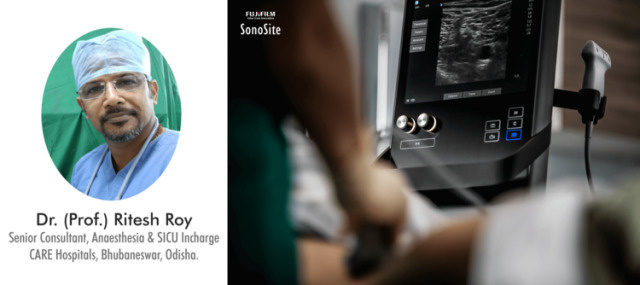
Ultrasound guided regional anaesthesia (USGRA) in 21st century has set a new standard of perioperative care for a wide range of surgical sub-specialty procedures, including orthopaedic, general, thoracic, colourectal, breast, gynaecologic and cosmetic surgery. The use of Ultrasound guided regional anaesthesia has emerged as an important component of enhanced recovery after surgery (ERAS) protocols, designed to optimise patient co-morbidities before surgery, reduce stress responses after surgery, and promote early physical therapy and return to daily activities. ERAS implementation has also proven effective in reducing length of stay, morbidity and readmission rates.
The use of a multimodal analgesic pathway that has incorporated ultrasound guided regional techniques as a part of multimodal analgesia is associated with improved pain scores, lower opioid requirements, early ambulation, physical therapy participation, increased patient satisfaction, shorter hospital stays and fewer complications after surgeries.
Increasing evidence shows that the types of anaesthesia and analgesia administered in the perioperative period may affect the rates of surgical site infection, urinary retention, ileus, nausea and vomiting, and the ability to safely participate in early postoperative rehabilitation.
The operation theatre is a hospital’s most important revenue stream and multimodal analgesia with USGRA being one important part helps hospitals maximize through output in this very expensive space. Skilled ultrasound guided regional anaesthesia also facilitates the growing demand by surgeons and patients for complex cases in ambulatory settings, which builds revenue for hospital without compromising patient safety. Innovative ultrasound guided regional anaesthesia techniques yield strategic advantages for hospitals and ambulatory surgical centres, enabling the delivery of high quality care in a cost-conscious environment.
In the modern age of regional anaesthesia, the majority of surgeons recognise that ultrasound guided nerve blocks have significant advantages for many patients, yet regional anaesthesia programmes are most effective when they are championed by anaesthesiologist leaders who can communicate and collabourate with surgical teams as well as healthcare administrators. Anaesthesia providers have a tremendous ability to design and deploy ERAS programmes that deliver the highest-quality collabourative care and service experience for their patients. FUJIFILM Sonosite through its educational platform helps in creating those anaesthesia leaders who can master ultrasound guided regional blocks and carry forward ERAS protocol at their centre.
This is the time to master and embrace ultrasound guided regional anaesthesia and build a win-win ERAS programme that meets the needs of patient, clinicians and healthcare stakeholders-one that gives healthcare facilities a valuable competitive edge and yields success for all stakeholders in today’s evolving healthcare landscape.
My interest in regional anaesthesia as a part of multimodal analgesia started around 12 years back but it was limited to mainly orthopaedics surgery as it was all PNS guided blocks. The interest in ultrasound guided blocks started around 7 years back and thanks to FUJIFILM Sonosite educational platform started attending Hands-on workshop all across India. Since last 4 years I have been practicing ultrasound guided regional anaesthesia with FUJIFILM Sonosite Edge II colour doppler Ultrasound machine at our hospital, which is a 300 bedded setup catering to all super specialty surgery. The image quality of FUJIFILM Sonosite ultrasound has helped us provide quality USGRA, which is a key part of our multimodal analgesia in ERAS protocol for different type of surgeries.
FUJIFILM Sonosite as a main academic partner has helped us in starting a Hands-on ultrasound guided regional anaesthesia course to train new upcoming anaesthesiologists to help them in starting USGRA at their centre and start implementing ERAS protocol.

